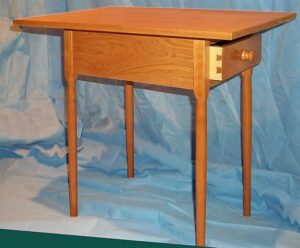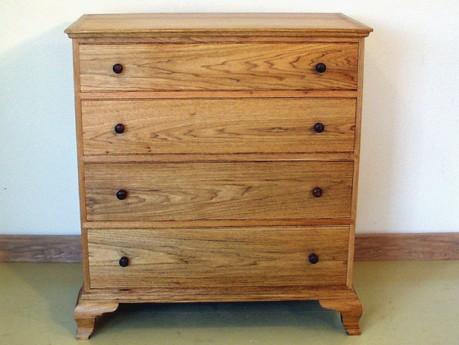
Butternut was used extensively by early settlers of North America. The nuts produced dyes and oils, and the sap was boiled down into syrup. Butternut may be best known, however, for its use as paneling on case goods.
Sometimes called “white walnut” or “oil nut”, butternut wood is both easily worked and attractive. Novice woodworkers often use butternut to practice planing, cutting, and carving on. Power tools, on the other hand, have an unfortunate tendency to damage butternut wood because the soft, stringy fibers tend to tear away when routed. One way to combat this is to route the ends first; any tearing along the edges will be removed when you route the sides. It’s also important to use sharp tools when dealing with butternut. Always finish-sand with the grain; butternut often exhibits cross-grain scratches when sanded improperly.
Butternut is lightweight and soft compared to most other hardwoods. It is susceptible to denting and is best used as an accent, rather than the primary wood on an often-used piece of furniture.
Because the tree never grows in stands but instead favors areas with sparse vegetation and rarely reaches a diameter of more than two feet, butternut wood is relatively rare. The trees are susceptible to attacks by fungus and worms, too. Expect to pay $3-$4+ per board foot of this wood. Today, some artisans still create furniture from butternut wood; rustic and Amish-style offerings are the most common styles available.

The sapwood is a creamy, almost white color, while the tan heartwood boasts unusual variegated patterns of pinkish brown. Freshly cut wood often shows streaks of green, gray, and pink; these fade and eventually disappear as the wood ages. It absorbs stain well, and no special precautions are required to prevent streaking or splotching. When stained brown, butternut is indistinguishable from black walnut because the grain patterns and pore structure are nearly identical.
Today, and handful of artisans still create furniture from butternut wood; rustic and Amish-style offerings are the most common styles available.
Butternut Dresser Image by Hawkridge Furniture, www.hawkridgefurniture.com
Amish and Shaker Style Table Photo Courtesy M. Ballatine

